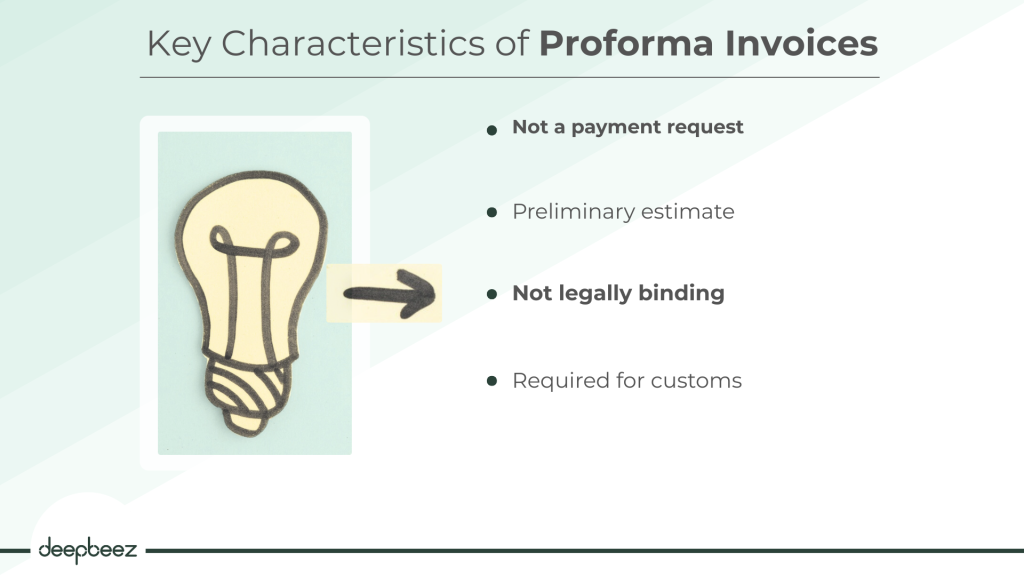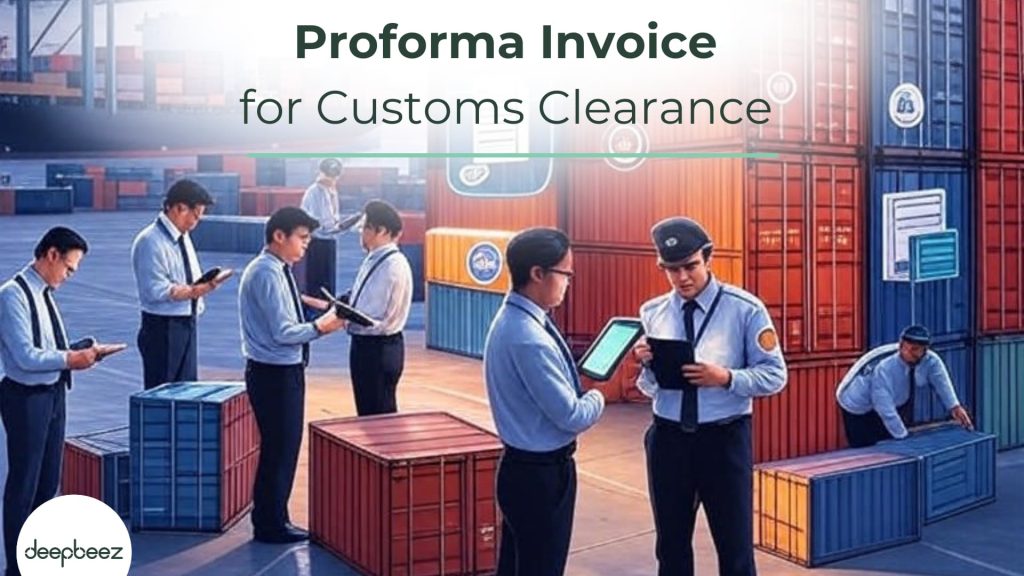What is a proforma Invoice? A pro forma invoice functions as a preliminary sales document that sellers provide to buyers, usually to secure advance payment before delivering goods or services. This document acts as a projected total or cost estimate for a transaction, detailing specifics about the purchase, items involved, and payment terms. In essence, it represents a formal quotation or order acknowledgment rather than a true invoice or payment demand.
What distinguishes a pro forma invoice from other standard business and logistics documents is its preliminary nature—it’s not a final, legally enforceable payment request. Instead, it provides an anticipated total or cost projection for a transaction, specifying purchase details, merchandise information, and payment arrangements prior to the actual delivery of goods or services.”
Using the right HS code for your product is one of the most important steps in creating pro forma invoices. If you are still unsure about the most accurate HTS code for your product, Deepbeez HTS code lookup will help you along the way.
What Is Proforma Invoice for Customs Clearance?
A pro forma invoice is essentially “an invoice that’s actually not an invoice” – I know, that sounds confusing at first! Think of it as a preliminary estimate or a detailed quote that looks like an invoice but doesn’t actually request payment.
The term “pro forma” comes from Latin, meaning “for the sake of form.” It’s basically a courtesy document that helps satisfy certain requirements without being legally binding. Pretty neat, right? Did you also know that you can stay customs compliance and avoid fines by correct HTS code lookup?
Key Characteristics of Pro Forma Invoices
Here’s what makes pro forma invoices unique:
- Not a payment request: Unlike regular invoices, these don’t ask your customer to pay anything
- Preliminary estimate: They give buyers a clear picture of costs and terms before any formal agreement
- Not legally binding: Terms can still be negotiated and changed
- Required for customs: Essential for international shipments when no payment is due

Key Differences Between Proforma and Commercial Invoices
Now, let’s explore the main differences that every business owner should understand:
| Aspect | Proforma Invoice | Commercial Invoice |
| Purpose | Preliminary estimate/quotation | Formal request for payment |
| Legal Status | Not legally binding | Legally binding document |
| Payment Request | No payment demanded | Formal payment request |
| Timing | Before sale agreement | After agreement is finalized |
| Customs Role | Limited (mainly for non-commercial shipments) | Essential for customs clearance |
| Validity Period | 30-90 days typically | No expiration date |
| Negotiability | Terms can be changed | Terms are fixed (require mutual consent to change) |
Do not forget that you also need to know what packing list document is and when it is necessary.
When Do You Need a Pro Forma Invoice?
Now, here’s where it gets practical. When exactly should you be using these documents? Let me walk you through the most common scenarios:
| Scenario | Why Pro Forma Invoice is Needed |
| Sample Shipments | Declare value for customs without requesting payment |
| Gifts and Donations | Show customs the value of items being gifted |
| Advance Payments | When goods are already paid for |
| Warranty Replacements | For spare parts and warranty items |
| Temporary Exports | Goods going abroad temporarily |
| Letter of Credit | Banks require them for financing |
What Is Key Information on Performa Invoice for Customs Clearance?
Let me ask you this: Have you ever needed to send product samples to potential international clients? Or maybe you’re replacing defective items under warranty? In these cases, a pro forma invoice becomes your best friend.
| Category | Required Details |
| Document Identification | • Clearly marked “PRO FORMA INVOICE”• Invoice number• Date of issue |
| Party Information | • Your company name and address• Customer name and address• Delivery address (if different) |
| Product Details | • Detailed description of goods/services• Quantity and units• Price per unit and total cost• Currency used |
| Customs Information | • HS codes (customs tariff numbers)• Country of origin• Gross and net weight• Reason for export |
| Commercial Terms | • Delivery terms (Incoterms)• VAT identification numbers• EORI numbers• Payment terms |
How to Create a Professional Proforma Invoice
Creating a proforma invoice might seem daunting, but it’s quite straightforward when you know what to include. Here’s your step-by-step guide and checklist for essential elements on the invoice:
| Section | Required Information | Notes |
| Header | “PROFORMA INVOICE” (clearly marked) | Use English and destination country language |
| Company Details | Your business name, address, contact info | Include VAT ID and EORI number if applicable |
| Customer Information | Buyer’s name, address, contact details | Include delivery address if different |
| Document Details | Invoice number, date, validity period | Typically 30-90 days validity |
| Product/Service Details | Description, quantity, unit price, total | Include HS codes for international shipments |
| Terms and Conditions | Payment terms, delivery terms (Incoterms) | Specify currency and any discounts |
| Additional Information | Country of origin, gross/net weight | Essential for customs clearance |
| Signatures | Your signature and company stamp | Adds authenticity and professionalism |
Discover more: What Is an Import Duty?
Step 1: Choose Your Method
- Manual creation using word processing software
- Download free templates (available in Word and PDF formats)
- Use automated systems like shipping platforms that generate customs documents
Step 2: Gather All Necessary Information
Before you start, make sure you have all the details about your products, customer, and shipping requirements.
Step 3: Fill in the Details Accurately
Remember, accuracy is crucial! The values you state must correspond to the actual worth of the goods. Never declare lower values to avoid duties – this constitutes tax evasion and can result in serious legal consequences.
Step 4: Review and Validate
Double-check all information, especially:
- Customer details and delivery address
- Product descriptions and HS codes
- Values and currency
- Terms and conditions
Step 5: Submit According to Requirements
Depending on your shipping method and destination, you may need to attach the proforma invoice to your shipment or submit it electronically.
When Do You Need a Proforma Invoice?
You might be wondering, “When exactly should I use a proforma invoice?” Here are the most common scenarios where they’re essential:
1- International Trade Scenarios
| Scenario | Why Proforma Invoice is Needed | Key Considerations |
| Sample Shipments | Customs requires value declaration even for non-commercial goods | Keep under 5 pieces and €50 value generally |
| Gifts and Donations | Must declare value for customs purposes | No payment expected, but value must be stated |
| Advance Payments | Basis for payment before goods are shipped | Acts as advance invoice for financing |
| Warranty Replacements | Customs clearance for replacement parts | Previous payment already made |
| Temporary Exports | Goods going abroad temporarily | Will return to origin country |
2- Business and Financial Scenarios
Are you dealing with any of these situations in your business?
- For Financing Purposes: Banks often require proforma invoices when businesses apply for letters of credit or trade financing. It shows the bank exactly what transaction you’re planning and helps them assess the risk.
- For Import Restrictions: Some countries have strict import controls. Submitting a proforma invoice in advance helps navigate currency exchange controls, import permits, and quota requirements.
- For Accounting Purposes: Sometimes you need to record an expense before receiving the actual invoice. A proforma invoice can serve as a placeholder in your accounting system.
Common Mistakes to Avoid in Proforma Invoice for Customs Clearance
Learning from others’ mistakes can save you significant trouble. Here are the most common errors businesses make:
Mistake 1: Using the wrong invoice type
- Don’t send a commercial invoice when you’re still negotiating
- Don’t use a proforma invoice when you want to request payment
Mistake 2: Inaccurate valuations
- Never undervalue goods to reduce customs duties
- Always reflect true market value
Mistake 3: Missing essential information
- Forgetting HS codes for international shipments
- Omitting important terms and conditions
Mistake 4: Poor communication
- Not explaining to customers which type of invoice you’re sending
- Failing to clarify next steps in the process
Understanding pro forma invoices might seem complex at first, but they’re actually straightforward once you know their purpose. Whether you’re sending samples, processing warranty claims, or helping customers secure financing, these documents play a crucial role in international business.
Remember, a pro forma invoice is your way of saying “Here’s what to expect” without the commitment of “Please pay now.” It’s a bridge between your initial business discussions and the final sale.
FAQ
- What exactly is a proforma invoice?
A proforma invoice is a preliminary bill of sale sent to buyers before goods are delivered or services are completed. Think of it as a detailed quote that looks like an invoice but isn’t legally binding. The term “proforma” means “as a matter of form” in Latin. - Is a proforma invoice legally binding?
No, proforma invoices are not legally binding documents. They’re estimates that can change before the final transaction. You cannot legally demand payment based solely on a proforma invoice. - When should I use a proforma invoice instead of a regular quote? Use proforma invoices when dealing with international trade, custom orders with variable costs, new customers who need detailed cost breakdowns, or when buyers need documentation for letters of credit or financing approval.
- Can I request payment using a proforma invoice? No, you cannot officially request payment with a proforma invoice. If someone pays based on a proforma, you should have a clear process for handling that payment and converting the proforma to a commercial invoice.
- Do I need to include VAT or tax information on a proforma invoice?
It’s recommended to include estimated VAT/tax amounts as separate line items so both parties understand the total anticipated cost. However, clearly specify that it’s “not a VAT invoice” to avoid confusion. - How long is a proforma invoice valid?
Validity periods typically range from 30-180 days, depending on your business needs. Always clearly state the validity period on the document since prices and terms may change over time. - Is a proforma invoice the same as a quote or estimate? Essentially yes, but proforma invoices are more formal and detailed. They look like actual invoices and include more comprehensive information than typical quotes, making them easier for finance teams to understand.
- Can a proforma invoice be canceled?
Since proforma invoices aren’t legally binding, they don’t technically need to be “canceled.” However, if terms change significantly, it’s good practice to issue a new proforma invoice with updated information. - Do proforma invoices affect my accounting records?
No, proforma invoices should not be recorded in your accounting books since they don’t represent actual sales. Only convert them to your accounts receivable when they become commercial invoices after delivery. - What comes first – proforma invoice or purchase order? This depends on your business relationship. New customers often receive proforma invoices first, then issue purchase orders if they accept the terms. Established customers might send purchase orders first, then receive proforma confirmation.
- How do I request a proforma invoice from a supplier?
Contact the supplier via email or phone, specify the products/services you need, quantities required, delivery location, and timeline. Mention that you need a proforma invoice for budgeting or approval purposes. - Are proforma invoices required for customs clearance?
Proforma invoices can be used for customs purposes when commercial invoices aren’t available (like for samples), but they’re not the preferred document. Commercial invoices are typically required for actual imports. - Can prices change between the proforma and final invoice?
Yes, prices can change since proforma invoices are estimates. However, significant changes should be communicated and agreed upon beforehand to maintain good customer relationships. - Should customers sign proforma invoices?
It’s optional but can create confusion about the document’s legal status. Most businesses don’t require signatures since proforma invoices are preliminary estimates, not contracts. - What happens after I send a proforma invoice?
The customer reviews the terms, may negotiate changes, and then either accepts (often by sending a purchase order) or declines. Once accepted and goods are delivered, you send the commercial invoice for payment. - Why do international businesses use proforma invoices more often?
International trade involves more complexity with customs, currency fluctuations, and shipping variables. Proforma invoices help establish clear expectations and provide documentation for letters of credit and import permits. - Can I convert a proforma invoice to a commercial invoice?
Yes, many accounting software systems allow you to convert proforma invoices to commercial invoices with one click after delivery. This saves time and ensures consistency between documents.





